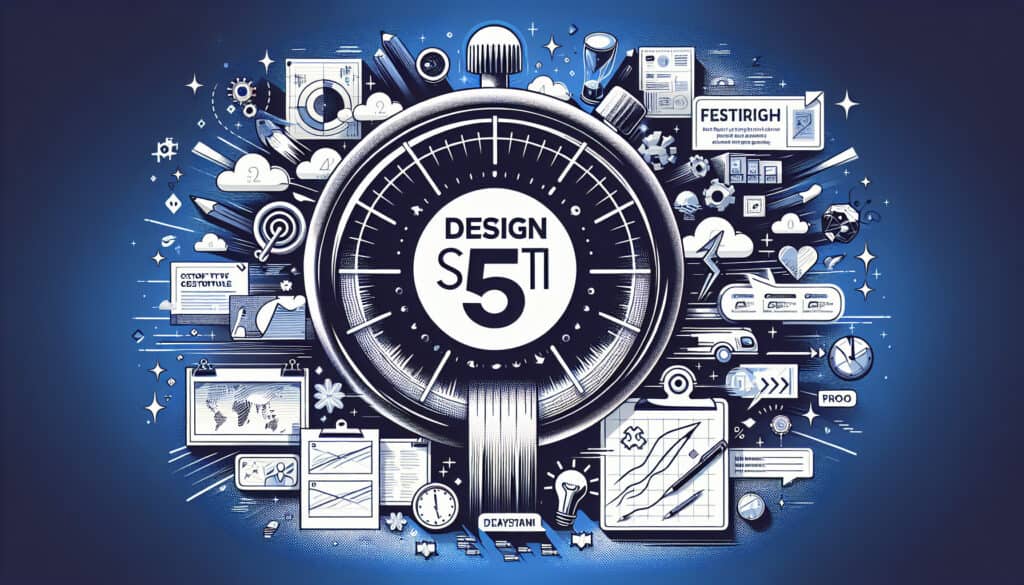Un proceso de cinco días con limitaciones de tiempo para responder a preguntas empresariales críticas mediante el diseño, la creación de prototipos y la prueba de ideas con los clientes.
- Metodologías: Ingeniería, Calidad
Sprints de diseño

Sprints de diseño
- Metodología ágil, Sprint de diseño, Pensamiento de diseño, Innovación, Desarrollo de productos, Creación de prototipos, Creación rápida de prototipos, Pruebas de usuario, Diseño centrado en el usuario
Objetivo:
Cómo se utiliza:
- Popularizado por Google Ventures, es una receta estructurada para que un pequeño equipo pase de un problema a una solución probada. Incluye comprender, esbozar, decidir, crear prototipos y probar.
Ventajas
- Produce un prototipo tangible, probado por el usuario, en sólo una semana; reduce el riesgo de construir el producto equivocado; crea alineación e impulso dentro del equipo.
Contras
- Requiere el compromiso a tiempo completo y concentrado de todo el equipo durante una semana; puede ser intenso y agotador; no sustituye al desarrollo de productos a largo plazo.
Categorías:
- Ideación, Resolución de problemas, Diseño de producto, Gestión de proyectos
Ideal para:
- Resolver rápidamente grandes retos y probar nuevas ideas con los usuarios en un proceso estructurado de cinco días.
Los Sprints de diseño son especialmente ventajosos en sectores como la tecnología, la sanidad y los productos de consumo, en los que la necesidad de iteraciones rápidas y de comentarios de los usuarios es primordial. Esta metodología puede emplearse eficazmente durante las primeras fases del proyecto, como antes de desarrollar un producto mínimo viable (Jugador Más Valioso (MVP)) o durante la fase de ideación del desarrollo del producto. Los equipos suelen iniciar un Sprint de Diseño cuando se encuentran con incertidumbres o retos importantes que podrían poner en peligro los plazos o presupuestos del proyecto. Entre los participantes suelen figurar miembros de equipos interfuncionales, como jefes de producto, diseñadores, desarrolladores y especialistas en marketing, lo que facilita perspectivas diversas que enriquecen el proceso de resolución de problemas. Por ejemplo, empresas tecnológicas como Slack y Airbnb han empleado con éxito Sprints de Diseño para diseñar funciones centradas en el usuario, ayudándoles a alinear rápidamente las ideas y validarlas mediante pruebas de usuario. El enfoque estructurado del sprint favorece una toma de decisiones centrada; al dedicar cinco días a un esfuerzo concentrado, los equipos pueden superar los escollos comunes asociados a los ciclos de diseño prolongados. La rapidez de esta metodología no sólo acelera el desarrollo, sino que también mejora la colaboración y la moral, ya que los miembros del equipo ven progresos inmediatos y resultados tangibles, que pueden compartir con las partes interesadas para garantizar la inversión o el apoyo continuos.
Pasos clave de esta metodología
- Comprender: Identificar el reto y recopilar información sobre el usuario y el espacio del problema.
- Esbozar: Generar soluciones individualmente mediante el esbozo de ideas y conceptos en papel.
- Decidir: Revisa los bocetos y selecciona las ideas más prometedoras para seguir adelante.
- Prototipo: Construir un prototipo rápido y de baja fidelidad que represente la solución seleccionada.
- Pruebas: Realice sesiones de prueba con los usuarios para recabar sus opiniones y observar las interacciones con el prototipo.
Consejos profesionales
- Implique a diversos miembros del equipo con conocimientos variados para potenciar la creatividad y descubrir soluciones únicas durante las fases de comprensión y esbozo.
- Dar prioridad a los comentarios de los usuarios a partir de las pruebas para iterar sobre el prototipo inmediatamente, en lugar de esperar a un ciclo de sprints posterior.
- Utilizar técnicas narrativas durante las presentaciones a las partes interesadas para comunicar los fundamentos de las decisiones de diseño y fomentar la aceptación de los pasos siguientes.
Leer y comparar varias metodologías, recomendamos el
> Amplio repositorio de metodologías <
junto con otras más de 400 metodologías.
Sus comentarios sobre esta metodología o información adicional son bienvenidos en la dirección sección de comentarios ↓ , así como cualquier idea o enlace relacionado con la ingeniería.
Contexto histórico
1949
1950
1950
1960
1960
1960
1960
1940
1950
1950
1958
1960
1960
1960
1960
(si se desconoce la fecha o no es relevante, por ejemplo "mecánica de fluidos", se ofrece una estimación redondeada de su notable aparición)















Publicaciones relacionadas
Gestión de operaciones de fabricación (MOM)
Sistema de Ejecución de Fabricación (MES)
Plan de control de la fabricación
Pruebas manuales
Tablas de evaluación de la manipulación manual (MAC)
ManTRA (Herramienta de evaluación de riesgos en las tareas manuales)